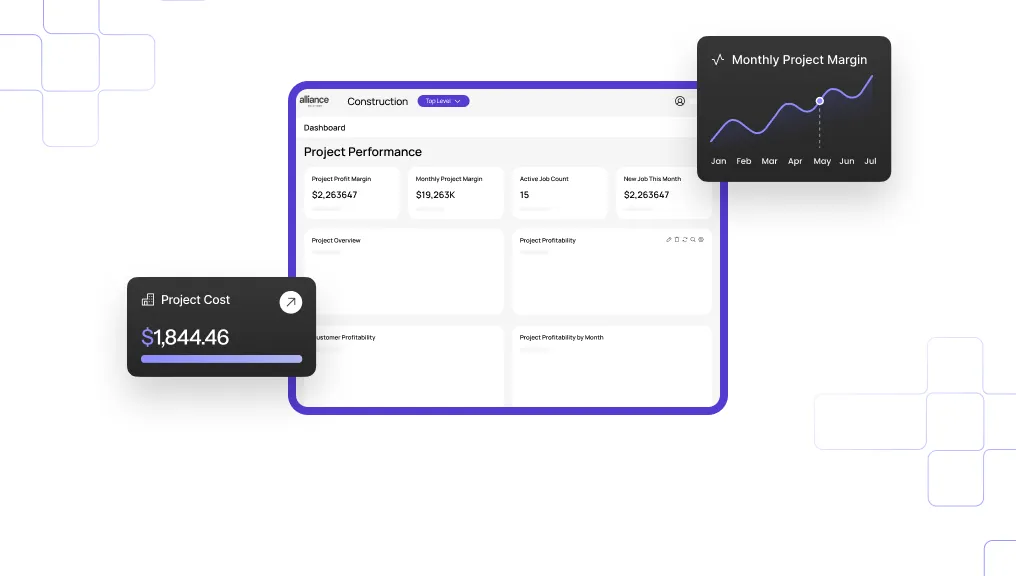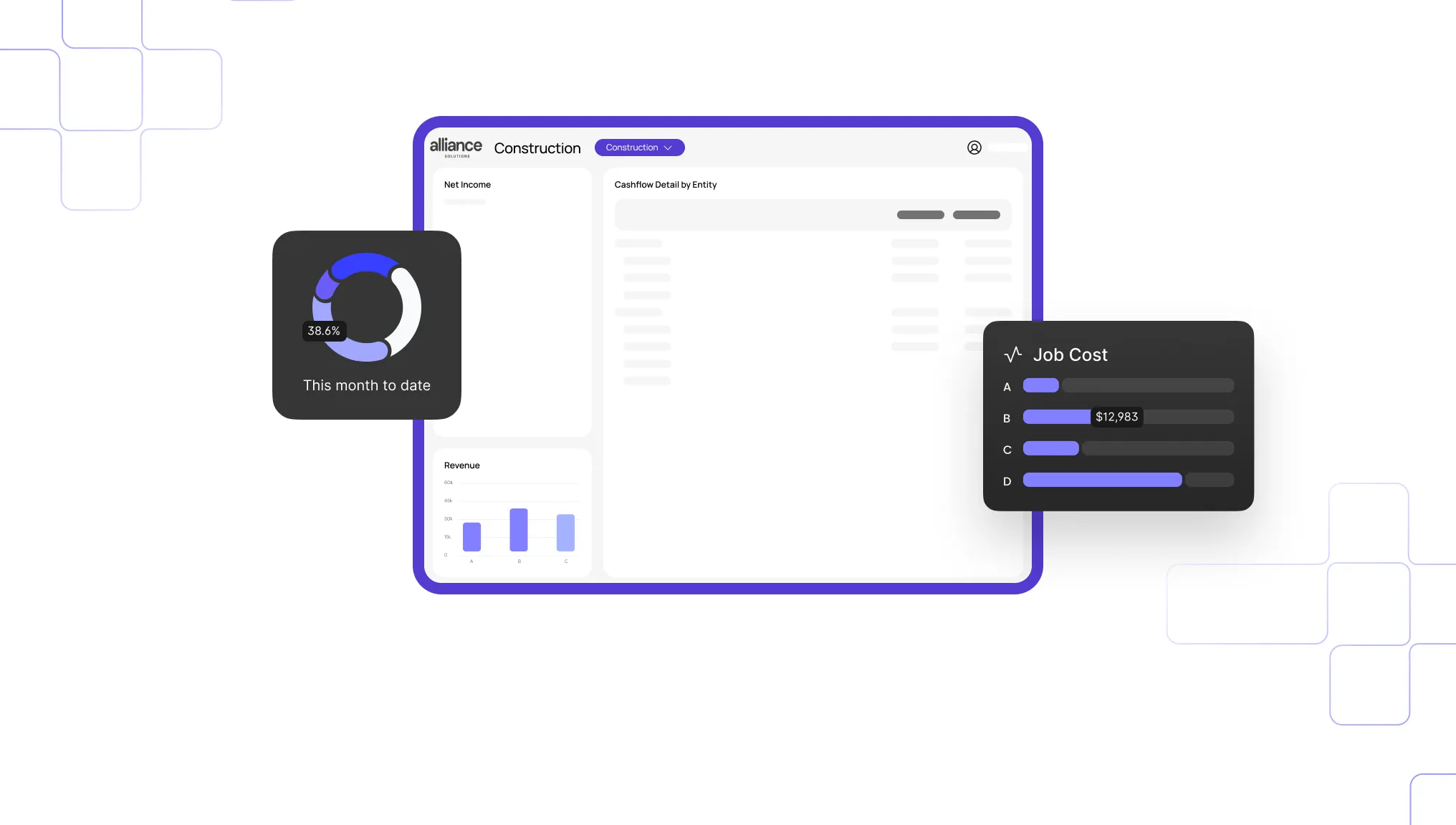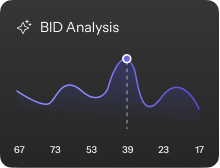Sage Intacct Construction:
Built for builders, powered
by the cloud.

Sage Intact Benefits
Build Confidently

Eliminate business blind spots.

Simplify and automate busy work.

Thrive with cloud software built for construction.
The most complete cloud
construction software out there.
more efficient business — with tools that connect your people, projects, processes, and profits.
Pre-Construction
BidMatrix, and eTakeoff Dimension.
Win more business with AI-powered takeoffs
and smart bid analysis.


Operations
Sage Construction Management. Mobilize your team.
Eliminate double entry. Manage tasks, RFIs, submittals,
labor, and schedules from any device.
.jpg)
.png)
Financial Management
profitability.
Automate billing, payroll, and WIP reports — and reduce
your reliance on clunky spreadsheets for good.
.jpg)
.png)
Trusted by the trades.
Fit for firms like yours.
The premier partner for
Sage Intacct Construction.

Dive into Alliance's recent blog posts.

Alliance Solutions Group Recognized as FY25 Sage Platinum Club Award Winner
Fort Lauderdale, FL — November 2025 — Alliance Solutions Group (ASG), a leader in construction and real estate financial technology, has been named a FY25 Sage Platinum Club Award winner, one of Sage’s highest partner recognitions. This award highlights ASG’s performance in delivering Sage Intacct Construction and helping contractors modernize financial management with cloud technology, automation, and real-time job cost visibility.
The Sage Platinum Club for Partners honors top Sage partners worldwide for exceptional customer success, strong cloud adoption, and consistent innovation. ASG’s selection demonstrates its ongoing commitment to helping construction organizations strengthen financial accuracy, improve operational efficiency, and scale confidently with Sage Intacct.
Why Sage Recognized Alliance Solutions Group
As construction companies face increasing pressure to operate with real-time data, integrated workflows, and accurate job cost reporting, ASG continues to play a crucial role in guiding firms through financial transformation.
ASG was recognized for:
- Proven expertise in Sage Intacct Construction
- Strong customer outcomes with measurable financial improvements
- Leadership in cloud accounting and automation technology
- Deep construction-industry knowledge and long-term client support
ASG’s implementation framework, industry alignment, and focus on real-time financial visibility set it apart as a trusted partner for contractors and real estate organizations across North America.
Supporting Contractors in a Cloud-Driven and AI-Ready Future
Sage is investing heavily in cloud, automation, and AI capabilities within Sage Intacct. As a top partner, ASG helps customers adopt these advancements to replace manual processes, eliminate data silos, and strengthen decision-making across the business.
Construction companies working with ASG benefit from:
- Real-time visibility into financial and job cost data
- Faster, more accurate reporting
- Improved WIP management and cash flow oversight
- Scalable financial systems designed for long-term growth
This recognition reinforces ASG’s role as one of the most experienced and specialized partners for Sage Intacct Construction.
Read the Official Sage FY25 Platinum Club Announcement
To see Sage’s full announcement of the FY25 Platinum Club Awards, visit:
👉 View the official press release on Sage.com
Work With a Sage Platinum Club Award–Winning Partner
As a FY25 Sage Platinum Club Award winner, Alliance Solutions Group continues to deliver best-in-class implementations, training, support, and construction-specific expertise for Sage Intacct Construction.
Ready to modernize your financial operations with a top Sage partner?
Book a Demo with Alliance Solutions Group
Take a Sage Intacct Product Tour
Strengthen visibility. Improve accuracy. Build a scalable financial foundation.

Strong Contractors Build Strong WIPs: A CFO’s Guide to Bonding Readiness
Bond renewals are getting tougher as surety companies tighten their standards and look deeper into how contractors manage risk, forecast costs, and protect profit. For CFOs in the electrical contracting world, one tool carries more weight than almost any other during bond reviews: the Work in Progress (WIP) report.
A strong WIP does more than record project progress. It tells your story. It shows whether your team is in control, if profits are holding, and if your processes can be trusted. When built right and kept current, it becomes one of your best assets for bonding confidence.
If you’re newer to Work in Progress reporting or want a quick refresher on the fundamentals, read our article on What Is WIP Reporting and Why It Matters.
Why Accurate WIP Reporting Strengthens Bonding Capacity
Surety agents and underwriters rely on your WIP to assess financial health and operational discipline. They look for profitability trends, consistent job performance, and early indicators of risk. Profit fade, unapproved change orders, and large underbillings can all raise red flags.
For electrical subcontractors, where margins are thin and materials like copper fluctuate weekly, real-time, automated WIP visibility reveals your true exposure. It enables your team to adjust labor, manage cash flow, and forecast material impacts before they threaten margin — and the surety sees that stability as strength.
For CFOs, that means using data to tell a consistent story — one that proves stability and financial discipline. Simply put, an accurate, well-managed WIP gives you credibility. It shows that you’re proactive, not reactive, and that your numbers reflect what’s truly happening on the job.
What a Strong WIP Report Looks Like (and Why It Matters)
A well-built WIP includes more than totals and percent complete. It should show the full financial picture of every active job, including:
- Original and revised contract values with approved change orders reflected immediately
- Verified estimated costs to complete (by project managers)
- Costs to date and percent complete based on earned progress
- Overbillings and underbillings with clear explanations
- Retainage tracking aligned with AIA billing
- Committed costs for POs and subcontracts
These elements work together to give both management and sureties a true view of profitability and cash position. When you can explain every line confidently, your bonding partner knows you’re in control.
Here are a few key metrics sureties look for in every WIP report:
- Gross profit consistency from job start to finish
- Percentage complete accuracy based on real costs
- Over/Under-billing trends and late-stage underbilling
- Working capital quality, including cash, A/R aging, and retainage exposure
- Backlog gross profit and capacity remaining
To explore these metrics in more depth, check out this article on Five Key WIP Metrics Every Contractor Should Know. It explains how each measure impacts cash flow, forecasting, and margin protection in real time.
Why Automated WIP Updates Give Contractors a Competitive Edge
Many contractors still rely on monthly WIP reports, but today’s leaders are moving to automated, real-time updates that deliver a constant pulse on project performance. Automated WIP visibility helps you identify margin fade early, tighten cost controls, and eliminate end-of-month surprises.
For electrical contractors facing constant cost swings—from copper price spikes to unplanned overtime—automated updates create the time and insight needed to adjust course before profits slip. This consistency builds confidence with sureties and strengthens your financial position.
When project managers and finance teams collaborate through automated, real-time forecasting, WIP becomes more than a report—it’s a dynamic tool that safeguards cash flow and drives profitability.
Common WIP Reporting Mistakes That Hurt Bonding Capacity
Even strong contractors can fall into traps that erode surety confidence:
Treating overbilling as profit - It’s short-term cash flow, not margin. Keep it separate and plan for future costs.
Not tracking committed costs - Purchase orders and subcontracts must be included so exposure is real-time.
Using stale cost-to-complete data - Get project managers to review and re-forecast often. Their field knowledge is key.
Relying on spreadsheets - Version confusion and manual entry errors cause delays and mistrust. Modern systems eliminate that risk.
Sureties don’t expect perfection, but they value consistency and transparency. Contractors that update frequently and communicate clearly are seen as lower risk, and that directly strengthens their bonding position.
Fortunately, modern systems can automate these processes and eliminate the risks of manual entry.
How Sage Intacct Improves WIP Reporting for Contractors
For CFOs managing multiple active projects, accuracy depends on real-time data and integration between field and finance. That’s where Sage Intacct stands apart.
With Sage Intacct, your WIP report builds itself from live job costs, approved change orders, and up-to-date forecasts. Over and underbillings post automatically. Dashboards track margin trends and cash positions in real time. Retainage, AIA billing, and committed costs are captured without extra spreadsheets or manual re-entry.
The result is a clean, audit-ready WIP that gives you instant visibility and the confidence to walk into any bond renewal conversation prepared.
Frequently Asked Questions
Q1: What is a WIP report, and why does it matter for bonding?
A Work in Progress (WIP) report tracks the financial health of active jobs by comparing actual costs, earned revenue, and billings. Surety companies use it to evaluate profitability, accuracy, and how well a contractor manages project risk.
Q2: How can contractors keep WIP reports accurate without adding more manual work?
Automatic updates deliver better insight, but manual entry can slow teams down. By automating data flow between accounting and the field through systems like Sage Intacct, contractors can maintain real-time WIP accuracy without extra effort.
Q3: What does “profit fade” mean, and why do sureties care?
Profit fade occurs when a job’s expected gross profit decreases as it progresses. Consistent profit fade can signal weak estimating, poor project control, or inaccurate forecasting — all of which make a surety less confident in extending capacity.
Q4: How does Sage Intacct improve WIP visibility for CFOs?
It centralizes project costs, change orders, and billing data in one place so your WIP updates automatically. The result is faster insight, fewer errors, and reports that are always bond-ready.
Build WIP Strength That Inspires Confidence
Every bond renewal tells a story, and your WIP determines how it’s read. The stronger, cleaner, and more consistent your WIP reporting is, the more confidence your surety will have in your financial stability.
With Sage Intacct Construction, Alliance Solutions Group helps electrical contractors build reliable WIP systems that improve visibility, forecast accuracy, and cash flow. When your projects are tracked in real time and your numbers align across teams, you gain more than clarity — you gain leverage with every bond renewal.
Contact our team today to get started.

Five Key WIP Metrics Every Contractor Should Know
The numbers behind smarter project decisions in construction
- Part I: What is WIP Reporting and Why it Matters
- Part II: What’s the Difference Between Job Cost and WIP?
- Part III: How to Get Started with WIP
- Part IV: Understanding Key WIP Metrics (Earned Revenue, Over/Under Billings, FCAC)
- Part V: The Role of Project Managers in Accurate WIP Reporting
- Part VI: What to Look for in a WIP Reporting Solution
- Part VII: How Sage Intacct Automates WIP Reporting and Saves You Time
- Part VIII: How to Transition from Excel to Sage Intacct WIP Reporting?
A Work in Progress (WIP) report isn’t just a stack of numbers; it’s a story about your projects. Each calculation sheds light on where a job stands, whether profits are holding steady, and how billing compares to earned revenue. When you knowhow to read these numbers, you can make better, faster decisions to keep projects on track.
Here are the key WIP metrics every contractor should understand and what they tell you about your jobs.
1. Percent Complete
Formula: Job-to-date cost ÷ Forecasted cost at completion (FCAC)
What it tells you: How far along a project is based on costs incurred compared to the total expected cost.
This is the foundation for WIP reporting. If a project is 60% complete, you should be about 60% into your costs and about 60% into your earned revenue. If those percentages don’t align, it’s a red flag.
2. Earned Revenue
Formula: Percent complete × Total contract value
What it tells you: How much revenue your company has earned — not just billed — based on work performed to date.
Earned revenue matters because billing alone doesn’t always tell the truth. You might have billed ahead of progress (overbilling) or fallen behind on invoicing(underbilling). Earned revenue gives you the true financial picture, regardless of invoices sent.
3. Over/Under Billings
Formula: Billed amount – Earned revenue
What it tells you: Whether you’ve billed more (overbilling) or less (underbilling) than there venue you’ve earned.
Overbilling creates short-term cash flow but can mask underlying performance issues.
Underbillingmight mean slow invoicing, disputed change orders, or missed milestones . . .and that can strain cash flow if left unchecked.
Consistently tracking this metric helps you stay ahead of billing disputes and spot practices that could eat into profitability.
4. WIP Gross Profit
Formula: Earned revenue – Job-to-date cost
What it tells you: The profitability of a project at its current stage.
This is where the rubber meets the road. WIP gross profit shows whether the project is on pace to meet its margin goals. If gross profit is shrinking compared to your original estimate, you may be seeing profit fade. This is a telltale sign that it’s time to review labor productivity, material costs, or scope changes.
5.Forecasted Cost at Completion (FCAC)
Formula: Job-to-date cost + Estimated cost to complete
What it tells you: The best estimate of the total cost of the project once finished.
FCAC is one of our favorite WIP numbers because it’s so powerful. It gives contractors the ability to look forward instead of just backward. If the forecasted cost creeps above the original budget, it’s a clear signal that corrective action is needed— whether that means tightening labor costs, renegotiating with subs, or addressing delays.
Why These Metrics Matter
On their own, each metric offers a snapshot of project health. Together, they create a complete picture:
- Percent complete shows where you are.
- Earned revenue tells you what you’ve earned so far.
- Over/under billings highlight billing practices that could hurt cash flow.
- WIP gross profit reveals if margins are holding steady.
- FCAC projects where you’re likely to end up.
When contractors use these numbers consistently, they gain visibility, predictability, and confidence — not just in a single job, but across the entire business.
Turning Metrics Into Action
The challenge isn’t just calculating these metrics. It’s making them part of a regular reporting process. That’s where software like Sage Intacct Construction makes the difference. Intacct automates calculations, pulls data directly from job costing, and presents real-time WIP metrics in one place. No more chasing spreadsheets or worrying about outdated numbers.
See WIP Metrics in Action
At Alliance Solutions Group, we help contractors turn raw numbers into reliable insights. With Sage Intacct Construction, we’ll show you how to track the right WIP metrics, generate accurate reports, and make decisions that protect your margins. Ready to see how it works? Contact us for a personalized demo.




.webp)